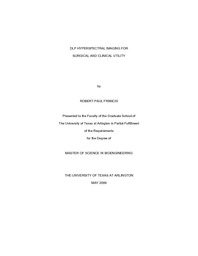| dc.description.abstract | Surgeons want technology to help them see differences in tissue chemistry. If they know how oxygenated tissues and organs are during medical procedures, they are more able to eliminate dangerous tissues and maintain viable organs. Hyperspectral imaging non-invasively measures the optical absorbance spectrum of each pixel in a spatial field of view and, with chemometric image processing, can visualize the spatial distribution of tissue oxygenation. Current hyperspectral imaging systems are too slow to monitor real-time physiological changes in live tissue. Therefore, a novel DLP Hyperspectral Imaging (DLP HSI) system is developed for real-time, non-invasive, in-vivo imaging of tissue chemistry in surgical and clinical applications. The cornerstone of the new hyperspectral imaging system is an OL 490 spectral light engine created with Texas Instruments' "Digital Light Processor" (DLP®) technology. In the OL 490, polychromatic visible light is dispersed onto the micromirror array of a DLP chip so that each column of micromirrors corresponds to a narrow band of monochromatic light. Programming the mirrors individually allows the user to precisely define the intensity of each wavelength in the light engine's optical output spectrum. The OL 490 can illuminate with narrow bandpasses of light as in traditional hyperspectral imaging, but the novelty of the DLP HSI is using the OL 490 to illuminate with complex broadband illumination spectra. Regardless of the illumination scheme, the light from the OL 490 is reflected from a tissue sample of interest and detected by a scientific grade CCD focal plane array. The spectral light engine and the camera detector are fully characterized as individual components, synchronized by software, and integrated into a robust system prototype that is transported throughout surgical and clinical suites. To visualize the spatial distribution of oxygenation, a Spectral Sweep mode mimics traditional hyperspectral imaging, explicitly measures the absorbance spectrum of each image pixel, and compares each spectrum to reference spectra of tissue chromophores. Spectral Sweep mode requires 20 seconds to generate a single image chemically-encoded for relative oxygenation. In contrast, a 3 Shot mode illuminates tissue with three complex broadband spectra derived from the reference spectra of tissue chromophores, measures the relative absorbance of the complex illuminations, and directly outputs an image also chemically-encoded for relative oxygenation. The 3 Shot mode can generate 3 chemically-encoded images every second. After calibrating and optimizing the performance of the DLP Hyperspectral Imaging system, the principle of visualizing oxygenation is proven by following the reactive hyperemia in an occluded finger example. The imaging system is then applied to partial nephrectomy, lower limb neuropathy, brain surgery, reactive hyperemia in the foot, and diabetic retinopathy. Representative images show that the system is useful for visualizing relative tissue oxygenation, but the absolute values are not yet calibrated. Overall, the DLP HSI is widely accepted by urologists, neurosurgeons, and clinicians. | en_US |

